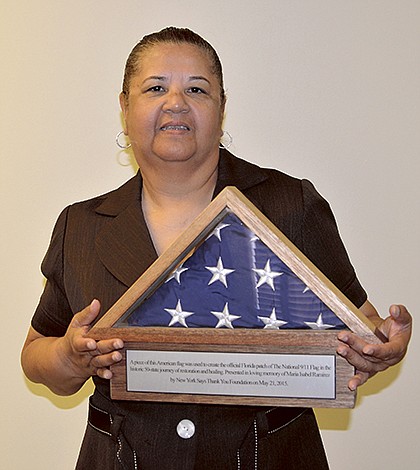- April 26, 2024
-
-
Loading

Loading

Some of Elsie Cintron-Rosado’s closest friendships have been forged in the last 14 years, but they are also a bittersweet reminder of what she has lost.
The Ocoee resident was in New York City last month to meet a group of them — all gathered to participate in a program named for her daughter and another man who were among the 2,977 victims of the 9/11 terrorist attacks on America.
The New York Says Thank You Foundation held the Ramirez-Ferguson Award Ceremony as part of the official installation of the National 9/11 Flag May 21, at the National September 11 Memorial Museum. The award honors the memory of Maria Isabel Ramirez and George J. Ferguson, two employees at 90 West St., in Manhattan, directly across the street from the World Trade Center.
The tattered 30-foot flag was hung on the exterior of their office building in the days and weeks following 9/11 and became a symbol of America’s resilience.
The first recipients of the award were citizens “who went above and beyond the call of service in the historic grassroots restoration and display of the National 9/11 Flag,” according to the program. Among them were Charlie Vitchers and 9-year-old Christina-Taylor Green (posthumously).
Vitchers, a construction supervisor in charge of the cleanup project at Ground Zero, saved the flag with the intention of giving it an honorable retirement burning but instead stored it for seven years at his home in Pennsylvania.
Green was born Sept. 11, 2001, and dedicated her young life to service and volunteerism before being killed in the 2011 mass shooting in Arizona that critically wounded Congresswoman Gabby Giffords. The flag was flown at Green’s funeral.
Many of Cintron-Rosado’s family members accompanied her for the award ceremony and flag installation in the museum. Ramirez’s former fiance attended, as well.
Cintron-Rosado and Mary Ferguson, George’s widow, spoke during the program, and each received a shadowbox containing an American flag and a plaque in memory of her loved one: “A piece of this American flag was used to create the official Florida patch of the National 9/11 Flag in the historic 50-state journey of restoration and healing. Presented in loving memory of Maria Isabel Ramirez by New York Says Thank You Foundation on May 21, 2015.”
“I was so humbled by this gift,” Cintron-Rosado said. “The ceremony was nice and emotional. The people who got the award are good people.”
It took a lot of mental preparation to attend this moving ceremony, but she said it was important for her to be there. She still has not toured the entire 9/11 museum. She tried once before but was stopped by her daughter’s image on a giant quilt that includes the photographs of all of the victims of that September day in 2001.
Last month, this quilt was taken down and the American flag was put in its place to start its year on display. The two items will switch out annually.
A SYMBOL OF RESILIENCE
The restored National 9/11 Flag has traveled to all 50 states, and bits of history are woven into the stitches.
Cintron-Rosado has followed the flag’s journey throughout the United States closely and even attended multiple stitching events. She first met the foundation’s organizers in 2009 after finally agreeing to attend a ceremony at Ground Zero and read a list of victims’ names, her daughter included.
This restoration project began on the seventh anniversary of 9/11, when Vitchers, who volunteers with the New York Says Thank You Foundation, took the battered and frayed flag to Greensburg, Kansas, where foundation volunteers assisted in rebuilding the town after it was 95% destroyed by a tornado. Women in the local senior center began stitching the flag back together, using fragments of other flags destroyed in the tornado.
This large flag — with about a dozen smaller flags filling the holes — began touring the country, going on display at sports outlets and to events with first-responders and veterans. When it was suggested the flag be returned to its original configuration, the National 9/11 Flag Restoration Tour began. Retired American flags were used from each of the 50 states, and stitch by stitch, the flag began to resemble a whole one again.
Stitches were added in Texas by soldiers and students who survived the Fort Hood shootings; World War II veterans in Hawaii; and the family of Martin Luther King Jr. in Georgia. It was sewn by survivors of the Oklahoma City bombing, the Columbine shootings and Hurricane Katrina. Stitches were put in by big-city and small-town citizens all across America.
Because of the flag’s connection to Cintron-Rosado, it arrived in Ocoee on Feb. 19, 2011, and local veterans, politicians and residents placed stitches near the bottom.
The final patches were added to the flag Sept. 11, 2011, in Joplin, Missouri — 10 years after the flag was first damaged and four months after Joplin was destroyed in a tornado.
But the restoration tour wasn’t over yet. The Star-Spangled Banner Flag House Museum, in Baltimore, provided three red threads from the original Star-Spangled Banner. These were added to the blue threads that came from the American flag that cradled President Abraham Lincoln after he was shot at Ford’s Theater. These were donated by the Pike County Historical Society, in Milford, Pennsylvania, which maintains the Lincoln flag.
In May, the flag that touched — and was touched by — thousands of citizens was returned to its home in Manhattan.
“The National 9/11 Flag is living proof that love is stronger than hate,” said Jeff Parness, founder of the New York Says Thank You Foundation.
“This flag was broken, and now it’s whole,” Cintron-Rosado said. “It was a healing process for me, too.”
Contact Amy Quesinberry Rhode at [email protected].